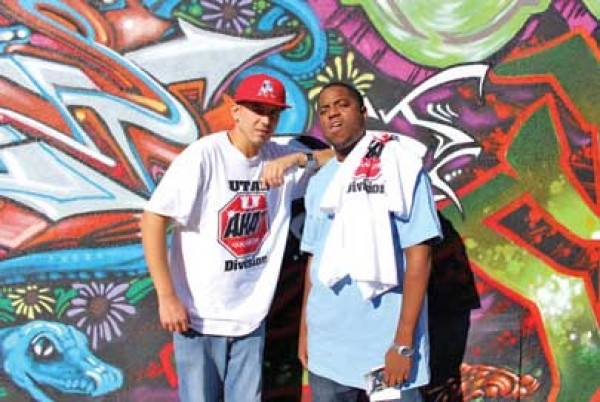
- Patrick Dick and Nick Fonseca
You have to be a very peculiar kind of creature to participate in a rap battle.
You should be dedicated and fiercely loyal; most of the time, there’s no money involved. You need to have a pachyderm’s skin, thick enough to protect you from your opponent’s claws. You should possess vulpine cleverness, conveyed in quick and cutting rhymes. Above all, you need to be out for blood.
“Why do people like a boxing match?” Nick Fonseca wonders aloud, sitting in the storefront on Orchard Drive in Bountiful that houses the studio he shares with Kim Lewis. “Who wants to see two people hurt each other? But the night of the fight …”
“It’s like modern-day gladiators,” Lewis says.
Fonseca is vice-president of Utah’s newest rap-battle league, All Hip-Hop All the Time, Utah division (AHAT Utah). Lewis is the league’s videographer and producer, responsible for editing and posting AHAT’s rap battles on YouTube. Given that the league was born during the Internet age, this is an important role. Not only does AHAT’s YouTube channel garner a far larger and more geographically dispersed audience than the events themselves, but bout winners are, in most cases, determined by the video’s comment section.
This novel form of judgment, according to Fonseca, has a few advantages: It’s a cooler venue for decision-making that’s away from the frenzy of a crowd. It’s easier, he says, to pay attention and to not mishear complex lyrics. There’s also what Fonseca calls “replay value”—going over a video with your friends, debating, disagreeing and hitting “play” until a consensus is reached.
“That’s kind of the bad thing for artists,” says Alex Mamatuki, also known as Playboi Short on the rap-battle circuit. Mamatuki is the current Utah champion and represented the division at a multistate AHAT battle in Las Vegas in January. He says he judges his performance by how he leaves the battle: “If I make somebody mad and I’m walking away from the battle laughing, I know that I won.”
In a rap battle, chances are that somebody is going to leave very, very mad.
No topic is off-limits for an emcee in the modern battle scene. A rapper’s appearance, name, family, girlfriend, race, sexual orientation and artistic ability are all considered valid points of contention in the ring. Emcees often look up their opponents’ public records, watch their YouTube videos and trawl their Facebook profiles for dirt. “You get to really dig deep and cut hard,” Lewis says. “You can come with your ‘yo mama’ jokes, but someone might come with your mom’s first name.”
Fonseca and Lewis make it clear that, as a league, AHAT doesn’t discriminate. “We’re here for everybody,” Lewis says. But they’re also adamant that their artists are afforded unfettered freedom of speech. Ultimately, they say, it’s the artistry that wins battles, not the slurs.
“You have to be witty,” Mamatuki says. “Every flaw you can think of about yourself, flip it. ... Make your weaknesses your strength.”
In contemporary rap battles, rhymes are written to order for each opponent. Pre-written raps may have been anathema in the old freestyle days, but Mamatuki says they allow rappers to refine their verses. “When you’re freestyling,” he says, you have “maybe one cool line out of every 30 seconds ... since everything [now] is mostly written, every line can be incredible.”
Another major difference in practice between the old-school rap battle and the new is the exclusion of music. “It gives your artists more of a chance to highlight their lyrics ... rather than just sounding cool over the beat,” says Fonseca, who was an emcee when the old school of battle prevailed. “A cappella, you can get more into freestyling it with your delivery.”
“It definitely gives you the chance to be free as an artist,” Lewis adds.
Perhaps appropriately for a battle league born in Las Vegas and raised across five Western states, freedom is a central theme in AHAT. The league is young and a touch upstart. The other major rap-battle leagues, King of the Dot and Ultimate Rap League, are based in Toronto and New York, respectively. In addition to Nevada and Utah, AHAT has divisions in Texas and California. Top-tier rappers have the opportunity to travel to different states—a major attraction for artists like Mamatuki, who also have more traditional hip-hop careers. Fonseca and Lewis say AHAT’s goal is national exposure, not for the league, but for the artists and the state.
“We want to shine a light on Utah,” Fonseca says.
AHAT UTAH
March Madness Mega Regional Rap Battle
w/ SEM No. 1 Crew, The Commission, The Paperboys, Ill Fede, Sire
Inferno Cantina
122 W. Pierpont Ave.
Saturday, March 2, 6 p.m.
$10 in advance, $15 at the door
AHAT.tv